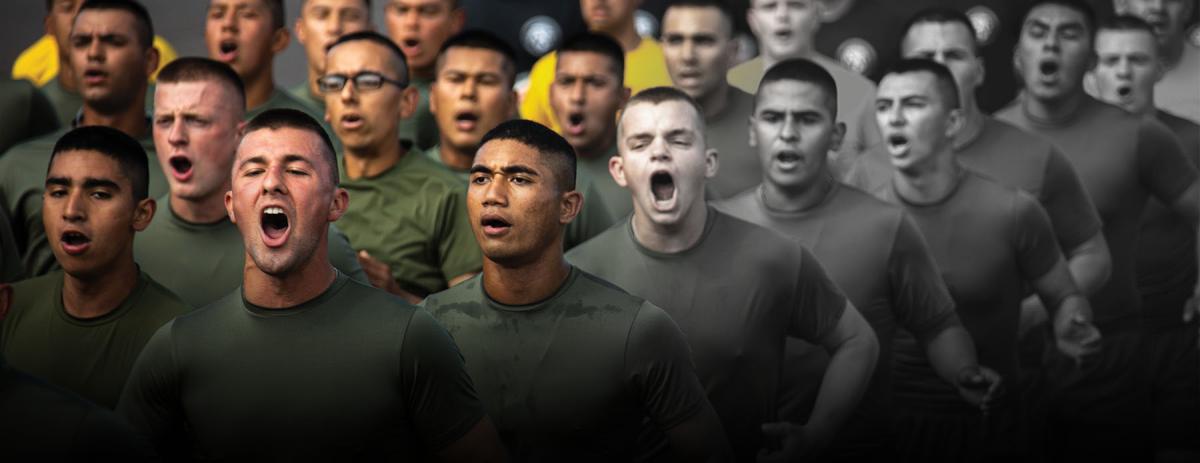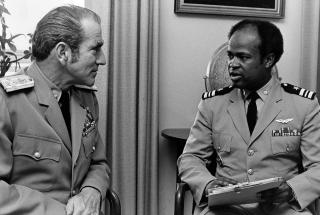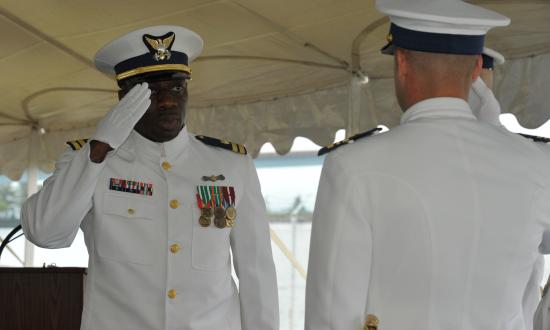“I am an invisible man . . . of substance, of flesh and bone, fiber and liquids . . . I am invisible, simply because people refuse to see me”
—Ralph Ellison, Invisible Man
During a July 2019 Senate nomination hearing for the Vice Chairmanship of the Joint Chiefs, Air Force General John Hyten testified that, unlike sexual assault, military commanders had effectively eradicated systemic racism from the ranks. He added, “When I am in uniform, I feel colorblind, which is amazing.”1 This sentiment reflects the theory of racial color-blindness: Eliminating discrimination by treating individuals as equally as possible—without regard to race, culture, or ethnicity—by choosing not to acknowledge these factors exist.2 This is prevalent in the United States and has deep roots in the Marine Corps.
Though racial color-blindness is not official Marine Corps policy, it is ingrained in the culture, and leaders often employ it to display impartiality. Many Marines proudly profess, “There are no black, brown, or white Marines—we are all green.” The sentiment means well, but color-blindness is a flawed practice that social scientists have proven ineffective.
Hands Over Eyes
Practically, the logic of racial color-blindness is unsound. The Merriam-Webster Dictionary provides six definitions for blind, all centered on sightlessness. None of these include voluntary action as a cause to that end. Accordingly, one cannot choose to be blind. Racial color-blindness is nothing more than covering one’s eyes in an attempt not to see. People cannot divorce themselves from their own race, culture, or ethnicity; therefore, no one should try to deem those characteristics invisible. Hands must be removed to reveal the stunning mosaic of diversity that holds the key to a fully optimized force.
Scientifically Falsified
Racial color-blindness is not a new idea. It originated during the U.S. civil rights era of the 1950s and 1960s as an attempt to adjust the blaring conversation about race to a more manageable volume.3 The past two decades have seen a rise in the idea’s prominence as Americans continue to grapple with the reality of racism, prejudice, and discrimination. Consequently, the application of racial color-blindness has been the subject of many professional and scientific reviews attempting to confirm its validity and measure its effectiveness. It has repeatedly failed those trials and been proven ineffective. Many psychologists and sociologists label racial color-blindness as encouragement to ignore the challenges that center on race in the United States.
A 2011 Princeton University study discovered the imposition of a negative cognitive cost on ethnic minorities subjected to environments embracing racial color-blindness. The study also found that positive interracial interactions decrease in racially color-blind organizations.5
No matter how well intentioned, it is counterproductive to cling to a concept that has been proven not to work and only stalls needed progress. Leaders must understand the dynamics present, which point to a need for change, and have the willingness and ability to drive organizations toward that change.
Leaders Must Lead
Ultimately, proclaiming racial color-blindness as a solution to racial disparities absolves leaders of their responsibilities to unlock the potential of diverse teams. It is well documented that ethnic, racial, and gender diverse teams are more effective than homogeneous teams. Authors of a 2016 Harvard Business Review article explained that multiple scientific studies show diverse teams focus more on facts, process those facts more carefully, and are more innovative.5 With that, it is important to understand that human beings are naturally drawn to people with whom they share common traits and backgrounds, which means all people have natural biases that can challenge trust. If teams are not managed to account for the differences among members, they likely will underperform in comparison with homogeneous teams because of the existence of trust gaps.6
It is imperative for leaders in diverse organizations to bridge those gaps by cultivating engaging environments that harmonize different knowledge bases, experiences, and information. Standards and policies must account for the growing diversity of the force, otherwise leaders will remain unaware of the organizational nuances that erode trust. When leaders choose to “cover their eyes” to race, they are decreasing their ability to maximize the potential of their units.
Every leader bears responsibility for building and sustaining an effective team. When the team is diverse, the leader must ensure that the team understands—beginning with him or herself—the value of each member and accounts for each one’s needs and capabilities. When leaders profess, “I don’t see color” or “we’re all green,” they are choosing to ignore key components of their subordinates’ identities. In the past, color-blindness has caused some Marine Corps leaders to be blind to severe racial disparities in military justice.
A nongovernment analysis of 2006–15 Department of Defense punishment data found that in comparison with their white counterparts, African American Marines were 161 percent more likely to be found guilty at court-martial, and 29 percent more likely to be found responsible in nonjudicial proceedings.7 These statistics represent a leadership failure centered on an inability to properly observe because of incomplete vision. Negative impacts on minority populations of this nature can be overlooked when, through a lens of racial color-blindness, those minority populations do not exist.
No Race Means No Racists
Even more directly damaging, leaders who profess to be racially color-blind allow bad actors to be camouflaged by the veil of a raceless force. After all, there can be no racists in an environment in which there is no race. This statement would seem to solve the problem of racism in the organization, yet multiple documented racists have recently served in the Marine Corps and other services. A staff sergeant and sergeant were arrested for hanging a white supremacist banner on a North Carolina courthouse in 2017, and a neo-Nazi lance corporal was convicted at a court martial for his actions at the bloody 2017 white supremacist rally in Charlottesville, Virginia. Overall, between 1997 and 2020, 13 investigations into white supremacy—which the Department of the Navy labeled as “major”—ended in the dismissal of the Marines and sailors involved.8
Color-blindness did not birth these examples. However, the approach is predicated on the elimination of race to eliminate racism and race-related discrimination. These examples highlight how self-professed racial color-blindness can allow the ideal to obscure reality. It can allow racists to hide in plain sight.
An Incomplete History
Marines are taught the Marine Corps’ history in detail during entry-level training. However, that history is shown through a narrow lens. Many Marines leave those classes believing the Marine Corps single-handedly fought and won every U.S. battle. Minority contributions to the Marine Corps’ history are often lumped together and introduced as a series of “firsts.” Later, in more advanced professional military education and follow-on training, Marines learn about all the coalition and joint contributions to the Marine Corps’ warfighting exploits and gain a more appropriate level of appreciation. While the Marine Corps opens the aperture on contributions to the service’s success from outside the force, this is never done regarding the contributions of Marines along the diversity spectrum. Just as entry-level Marines graduate boot camp or Officer Candidate School believing the Marine Corps performed gallantly and alone, they also graduate believing nearly all of the great contributions came from the racial majority, and this belief is never corrected.
The fact that the history of minority contributions to the service is taught through such a narrow lens has inadvertently cultivated an environment ripe for the application of racial color-blindness. It is difficult for Marines who are poorly educated on how diversity has significantly and positively affected the force to appreciate diversity.
Implicit Endorsement
The lack of an explicit organizational intent behind diversity and inclusion implicitly endorses racial color-blindness in the Marine Corps. In June 2021, the Deputy Commandant for Manpower and Reserve Affairs and the Director of Manpower Plans and Policy authored the Marine Corps Gazette article entitled, “Diversity, Equity & Inclusion: Why This Is Important to the Corps as a Warfighting Organization.”9 They attempted to provide the missing explicit intent but ultimately fell short. While their attempt speaks volumes, they do not establish intent of the force.
Likewise, during the 48th Annual National Naval Officers Association Symposium, Commandant General David H. Berger proclaimed that the Marine Corps supports diversity and inclusion.10 He has communicated a similar sentiment several times. While many of his directives and policy initiatives provide substantive actions that show such support, there is still an unclear and undeveloped vision on the “why” for that support.
The 23-page 38th Commandant’s Planning Guidance communicated “where the Marine Corps is going and why,” the Commandant’s intent, which energized a metamorphosis of the force.11 The document addressed the Marine Corps from all angles, including sections on force design, emerging operational concepts, and the divestment of forces and equipment. It also included extensive language on talent management initiatives and principles, including maternity/paternity leave and core values. However, for all it included and directed, what it did not mention carries weight. The words “color,” “diversity,” and “race,” are not found in the guidance. Racial diversity is not addressed at all in the document. Marine Corps leaders must understand and be able to articulate why diversity is critical to the service’s future success. Their ability to do so starts with a clear commander’s intent from the Commandant.
Meaningful Steps Forward
First, the Marine Corps should disavow color-blindness. While the concept appears sound, it entices many well-intentioned Marines down the path of a false panacea. Studies have shown that individuals who avoid acknowledging race appear more biased, and that “racially color-blind” workplaces correlate with decreased engagement by minority employees and increased belief that the organization’s climate is racially biased.13 Marines must know that “we are all green” is actually a counterproductive expression, and that many in the ranks feel that “if you don’t see color, then you don’t see me.”13
Next, the Marine Corps should revamp its history education to emphasize the evolution of the force and contributions of minority Marines. Retired Marine Colonel and Director of the Marine Corps Leadership Seminar Dr. Kenneth D. Dunn is working to address this. In September 2020, he proposed adding to the Marine Corps University staff a Diversity Chair named for Lieutenant General Frank E. Petersen. The Diversity Chair would assist the university in adopting course materials that reflect the rich heritage of diversity within the service. In addition, this Chair would assist in hiring a more diverse pool of candidates to close some of the cultural gaps in the Marine Corps’ education process. As Dr. Dunn explains, “Names like Petersen, Huff, Capers, and Canley can be spoken with the same reverence as Puller, Butler, and Daly. This can happen through thought-provoking learning objectives taught by knowledgeable faculty.”14
Lastly, the Commandant should communicate his intent for diversity and inclusion to the force explicitly in writing. His ability to tie his intent directly to the operational effectiveness of the envisioned 2030 Marine Corps is vital. Commanders should abandon attempts to be color-blind and carry the Commandant’s message to the service.
Opposing Views to Dialogue
In the “post George Floyd” era in the United States, people report “diversity fatigue” and argue that talking about race with such frequency and intensity is making the situation worse. However, that reasoning is rooted in a desire for comfort and not the need for organizational growth. Frank and progressive dialogues regarding race can have significant positive effects for individual Marines, units, and the service. The dialogue on race in the United States may seem exhausting to some, but for those who personally experience negative effects, the conversation is essential and overdue.
In 1970, a relatively simple dialogue between Chief of Naval Operations Admiral Elmo Zumwalt and Lieutenant Commander William Norman resulted in significant, positive, and enduring changes to Navy approaches and policies related to race.16 On a smaller scale, dialogue between Marine Staff Sergeant Cherie Wright and members of the Marine Corps Uniform Board led to the approval of lock and twist hairstyles in uniform in 2016. That policy change allows African American Marines to express their cultural identity at no cost to good order, discipline, or combat effectiveness.
Finally, some argue that color-blindness is in keeping with the military principle of “team over the individual.” The team is a central premise of a military system, and individualism—which posits that the interests of the individual are paramount—is dangerous to that system. Fortunately, innate human characteristics such as race, ethnicity, and gender have no relationship with the type of individualism that undermines military systems. Arguments for a color-blind Marine Corps that focus on avoiding individualism fatally conflate this distinction.
A person who is clinically color-blind—without the ability to distinguish chromatic colors—is handicapped in what can be seen. In the current operating environment, it is important to reimagine ideas that once were fully accepted. The Marine Corps is not composed of colorless men and women and does not operate in a colorless world. Consequently, an attempt to operate without seeing color is misguided and untenable. Color-blindness is a false panacea that undermines the contributions of individual Marines and weakens unit cohesion.
1. Hearing to consider the nomination of General John E. Hyten, U.S. Air Force, for reappointment to the grade of general and to be Vice Chairman of the Joint Chiefs of Staff, 116th Cong. (2019) (testimony of John Hyten).
2. Monica Williams, “Colorblind Ideology Is a Form of Racism,” Psychology Today, 27 December 2011.
3. Amy Ansell, Race and Ethnicity, The Key Concepts (New York: Routledge, 2013).
4. Deborah Son Holoien and J. Nicole Shelton, “You Deplete Me: The Cognitive Costs of Colorblindness on Ethnic Minorities,” Journal of Experimental Social Psychology 48, no. 2 (1 October 2011): 205–9.
5. David Rock and Heidi Grant, “Why Diverse Teams Are Smarter,” Harvard Business Review, 4 November 2016.
6. Ajit Verghese, “Diversity Is the Superpower Organizations Need to Cultivate for Success in 2021,” Humble, 24 December 2020.
7. Daniel Brown, “New Study Finds that Black Troops Are Way More Likely to Be Punished than White Troops,” Business Insider, 7 June 2017.
8. Joseph Choi, “Navy, Marines Investigated 13 White Supremacy Cases, Held No Court-Martials: USA Today,” The Hill, 13 April 2021.
9. LTGEN David Ottignon and BGEN Jason Woodworth, USMC, “Diversity, Equity & Inclusion: Why This Is Important to the Corps as a Warfighting Organization,” Marine Corps Gazette, June 2021.
10. The National Naval Officer Association is self-described as a professional organization composed of active-duty, reserve and retired officers, and civilians who seek diversity and inclusive membership. The mission of the association is to enhance Sea Service operational readiness by supporting recruiting, professional development, and retention in an effort to achieve a diverse officer corps that reflects the demographics of our nation. GEN David Berger, “CMC Remarks, Gen Berger, 48th Annual NNOA Virtual Symposium,” filed 6 August 2020. Video of remarks, 2:55:23, https://youtu.be/4AFzmkhXO7w.
11. Gen David H. Berger, USMC, 38th Commandant’s Planning Guidance (Washington, DC: Headquarters Marine Corps, 2020), 1.
12. Evan P. Apfelbaum, Michael I. Norton, and Samuel R. Sommers, “Racial Color Blindness: Emergence, Practice, and Implications,” Current Directions in Psychological Science 21, no. 3 (2012): 205–9, 2012.
13. Lauren Arnold, “Opinion: If You Don’t See Color, You Don’t See Me,” Colorado University Independent, 25 April 2017.
14. Kenneth Dunn, “The Petersen Chair at Marine Corps University,” Marine Corps Gazette, September 2020.
15. Command equal opportunity advisors were appointed. There was an increase in minority representation among officers and enlisted sailors. Racial-awareness training and education were instituted. A requirement for Navy bases and stations to employ qualified African American civilian was enacted.








